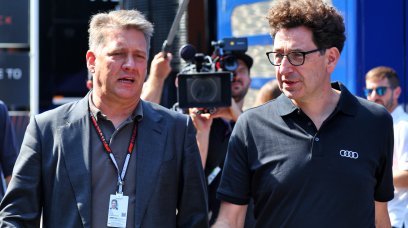For the second time in five years at the Italian Grand Prix, only the pole-sitter started where they actually qualified. Back in 2017, Lewis Hamilton's record-breaking 69th pole position meant he was on pole as the rest of the field was jumbled up due to the number of engine related penalties incurred. In 2022, the same was of Charles Leclerc as sixth-place qualifier George Russell was bumped up to the front-row in the Mercedes. Owing to Monza being the final opportunity for engine grid penalties before a series of tricky overtaking tracks, F1 teams decided to stock up on components with nine drivers taking new parts either voluntarily - or in the case of Hamilton, forced. But the look of multiple grid penalties at Monza was not good for F1 - especially as its on-track product has improved and it is currently enjoying a popularity surge. How do grid penalties actually work - and why was Sergio Perez given a 10-place drop for taking the exact same component as teammate Max Verstappen, who was given five?
How grid penalties work
Essentially, engine grid penalties in F1 were brought in to prevent teams from throwing in new engines as they wished in the turbo hybrid era. Also a cost-capping device, each car is allocated a set number of each component - such as the Internal Combustion Engine (ICE) or MGU-H for the season depending on how many races there are. Components are allocated to the car as opposed to the driver so teams couldn't find a loophole and replace a driver mid-season once his components had run out. For example, in 2022 the permitted number of ICEs allowed to be used penalty-free is three, with the penalty system such that if a fourth is taken, a 10 place penalty is applied. Any more than four ICEs used is a further five places for each new one, although teams are now banned from stockpiling components into their pool as they used to do in the early turbo hybrid days. This explains why Perez was given a 10 place penalty at Monza for taking a new ICE, while Verstappen was hit with five. It was the Mexican's fourth ICE of the campaign, compared to Verstappen's fifth, hence the difference for the same crime. Try explaining the Perez/Verstappen situation to a new fan of F1, and it's possible you'll be met with a blank face or a reply of: "What?" Further to the confusion is the way the grid is actually formed when there is a high number of penalties. Those with five or 10 place drops are shuffled back first, with any 'back of the grid' drops, such as Lewis Hamilton's at Monza, then factored in. The grid is then closed up to give the final starting order. However, well intentioned the system may be, it is clumsy and over-complicated. The way to go is not to simply do away with grid penalties and let the teams have free reign, as they'd find any advantage they could, but a simplification of the process is needed.
Points deductions are not the answer
Long suggested as a solution to the grid penalty saga is to dock Constructors' Championship points from teams who equip drivers with fresh components. However, again try explaining this to someone you've just met or in the pub. ' Yeah mate, Verstappen finished first after qualifying second but starting seventh with Red Bull only getting 50% of the points, after he took a fifth ICE of three allowed for the season. F1 needs to be simple in its approach to grid penalties - which remain a good deterrent in principle. The solution could be to simply do-away with the five or 10 place grid drops, and give anyone who takes a component exceeding their allocation a back of the grid penalty. As is the current situation, any cars at the back of the grid line up in their qualifying order, with Carlos Sainz Jr starting ahead of Hamilton and Yuki Tsunoda in Italy after the trio were sent to the back. All such affected cars are then given a drive-through on the opening lap. Clear, simple and easy to understand with complex mathematical formulas to figure out points off here and there. For example, in NASCAR, if a car fails pre-race tech three times, it is given a drive-through on the opening lap, so there is precedent for it in wider motorsport. It would be a great shame if all the good work the FIA and F1 have done to improve the series as an overall package, the spectre of a cumbersome engine grid penalty system hangs around for another season too long.
Most read








